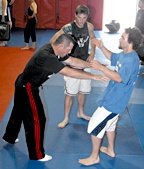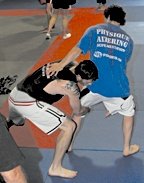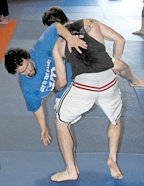What kind of training do you do?
Each day will vary. For instance, on a Monday, someone would come in and do functional fitness, plyos, a lot of off-the-ground training with weight vests, different types of pull-ups, rope climbing, weight lifting and running, whether it's track sprints, timed miles, 440s, 220s, ten 100 yard dashes, or carrying a guy on your shoulders or on your back up a stadium 5-6 times in a row. That would be a type of endurance workout.
Then you've got to do your technique training, whether it is learning submissions, submission escapes, positioning on the ground or how to get from one position to another. There's a lot of that to learn. Then they go home, have lunch and sleep, because they won't be able to come back and train hard in the evening if they don't rest their body.
 Tonight, the fighters will be training 12 three-minute rounds with 30 second rests in between. It's all stand-up fighting to focus on that portion of their game. Then, at the end, we'll probably go over to a hill that takes 1 1/2 minutes to get up and they'll have to do that 10-12 times in a row, and that'll be the end of the training session.
Tonight, the fighters will be training 12 three-minute rounds with 30 second rests in between. It's all stand-up fighting to focus on that portion of their game. Then, at the end, we'll probably go over to a hill that takes 1 1/2 minutes to get up and they'll have to do that 10-12 times in a row, and that'll be the end of the training session.
What kind of nutritional regimen do the fighters follow?
Diet and supplementation are important. A lot of fighters have their own way of doing things, but it's generally the same as far as diet. For breakfast, somebody my size should be eating eight egg whites with spinach, and maybe some oatmeal with a little honey. I have to jump-start my metabolism every day and make sure it's churning right away to help burn fat.
Most fighters have a meal or a protein shake a couple hours later and then lunch, which would be a lean meat like chicken or fish, greens like broccoli, asparagus or spinach, and brown rice. We're always looking at rehydrating with a lot of fluids - at least 1-2 gallons of water per day.
 They'll have another protein shake a couple hours later. For some fighters, dinner is after training. Some will eat a small dinner before training and then after training, they'll eat again. Usually, it comes down to putting about 5-6 meals per day in your body.
They'll have another protein shake a couple hours later. For some fighters, dinner is after training. Some will eat a small dinner before training and then after training, they'll eat again. Usually, it comes down to putting about 5-6 meals per day in your body.
Supplementation includes mostly whey protein, glutamines and those types of supplements. For over a decade, our team has used one supplement that everybody that's won a world title out of this gym has used - an antioxidant formula used by some of the best marathon runners and triathletes in the world that I luckily got my hands on years ago. It's an incredible supplement. It allows your muscles to soak up about 25-30 percent more oxygen at a cellular level. Once my muscles run out of oxygen, they use sugar for energy, producing lactic acid. If my muscles don't have to revert to burning sugar for energy, they don't get tired and I can keep going every day harder and harder. And I don't need to recover like most people do. The antioxidants are very important.
Is there any additional health care your fighters need while they're training?
 Probably 90-95 percent of professional fighters out there use chiropractic to maintain their bodies. It takes them awhile to understand you don't go to see the chiropractor for injuries; you go to maintain your body so you don't end up having injuries as often. Things that are about to happen to you don't because they're corrected before they can show themselves or manifest with pain.
Probably 90-95 percent of professional fighters out there use chiropractic to maintain their bodies. It takes them awhile to understand you don't go to see the chiropractor for injuries; you go to maintain your body so you don't end up having injuries as often. Things that are about to happen to you don't because they're corrected before they can show themselves or manifest with pain.
Can you give us an example of a situation in which you were injured and chiropractic played a role in your healing?
I could give examples all day. To give one example, I was training for my first fight in the UFC, my big shot, and I was up against the wrestling mats on the wall. We use the wall like a cage, and one of my training partners was trying to take me down. I had one leg out straight and the other one underneath me, and two 250 pound guys fell on my leg and buckled my knee the wrong way, doing a lot of damage to the ligaments. I couldn't bend my leg for two months.

